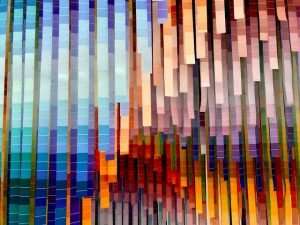“The Chicano Movement is the historical period from the 1960s to the 1980s in which Mexican-Americans struggled for social and political rights. It took place during a time of worldwide unrest, when many people were fighting for civil rights. The Chicano Art Movement is a movement that was started by people of Mexican descent and it played an important role in the Chicano Movement.”
Disclaimer: This account is based on my own knowledge and experience with this movement.
Introduction: I have been interested in art since I was very young. I have always enjoyed looking at paintings, whether they be in museums, galleries or even displayed on telephone poles. When I first heard about the Chicano Art Movement I was very intrigued by it because I realized that this was an art movement that was made up of people who were fighting for the same rights as me. I thought about how their art showed how hard it was for them to live as an oppressed people in a society that didn’t want them to exist; it also showed how proud they were of their heritage and culture.
This blog will be about the Chicano Movement and its contribution to modern American Art. It will cover the artists, works of art, exhibitions and organizations involved in this movement as well as information on why they
This artwork celebrates their heritage and reminds them that they are a part of this vibrant culture. The Chicano movement also created some of the most iconic pieces of art in America. The Chicano movement has had a lasting impact on modern American art and culture, and it continues to inspire generations of artists.
The Chicano movement was born out of political unrest in America over the Vietnam war, poverty, and social inequality. Many young people felt the government was failing them and it was time for a change. They wanted to be heard, so they began to make a stronger presence known by marching through the streets of many major U.S cities to raise awareness. These protests made their way into art as well and this was when the Chicano movement emerged in Los Angeles in 1967.
Chicanos brought new movements to mainstream art such as mural painting, printmaking, performance art, photography, film-making, poetry and music that were inspired by their struggle for civil rights in America. Artists reflected their views on society through these different mediums and used them as tools to express themselves freely.*”
Chicano art is a term used to describe the movement and artwork of a group of Mexican-Americans in the United States. Chicano art has evolved into one of the most popular and influential movements in modern American art.
The word “chicano” is a shortened form of the word “chicana,” which is a Spanish word meaning, “female.” Chicano is used to describe Mexican-American males, while chicana refers to Mexican-American females.
The Chicano movement was started by Mexican-American college students who wanted to redefine themselves and their culture. They focused mainly on political issues and had to struggle against negative stereotypes from both Hispanics and Anglos. The movement was also part of the larger counterculture movement that occurred during the 1960s.
Towards the end of the 1960s, there were two main types of Chicano art: mural painting and printmaking. Murals have been found painted on buildings throughout many cities, including Los Angeles, Albuquerque, New Mexico, San Diego and San Francisco in California. The murals usually reflected political themes such as racism, discrimination and oppression.*
In the United States, Chicano art has been around for a long time. It’s just that the world wasn’t ready for it.
The Chicano Movement was started in the 1960s by students who took their ethnocentric pride to a new level. The movement’s roots are in the Spanish conquest of Mexico and the Mexican Revolution of 1910. The movement continues today, with over 15 million people identifying as Chicano in some way (ChicanoArt.net).
Towards the end of World War II, young people were starting to see themselves differently than they had before, and this movement resulted. This was part of a larger social movement in the United States that became known as the civil rights movement.
The civil rights movement had two goals: equality for African Americans and freedom from discrimination for all people. The link between the Chicano Movement and civil rights is apparent in many ways, but one thing these groups have in common is their goal to redefine social norms (ChicanoArt.net).
As I mentioned before, Chicano art began decades ago but not everyone was ready for it at first. While it hasn’t always been seen as acceptable by mainstream society, there has always been much support for this type of art among Mexican-
Since the 1960s, the Chicano Movement has influenced the artistic world. From murals to films to literature and beyond, Chicano art has been used as a powerful tool to express the Chicano community’s struggles, experiences, and dreams.
The movement was started by students at California State University at Northridge in 1968, who formed the Chicano Coordinating Council and began publishing a newsletter called El Movimiento. In 1969, they published a manifesto called “El Plan Espiritual de Aztlán,” which stated that Chicanos were descendants of ancient Mexican civilizations, had been taken as prisoners to the United States, and were now oppressed by Anglo-American society.
As a result of this oppression, they were forced to live in barrios or ghettos while they watched their families and friends die from poverty, drugs and police brutality. The manifesto declared it was time for the people to regain control over their lives through political activism and cultural education.
The word “Chicano” was originally used as an insult towards Mexican immigrants during the 1930s. However, during the Chicano Movement of the 1960s it became a word of empowerment that expressed pride in being Mexican American.
Artists during this time expressed their pride in being
Chicano art is a style of visual art that is influenced by Mexican and Mexican-American culture, and the art from indigenous cultures. Chicano art shares many characteristics with Mexican folk art in that it has a connection to the past; it is not as concerned about being “modern” as European or American contemporary art.
Towards the end of the 1960s, artists who wanted to bring awareness of their cultural heritage began to create artwork that spoke to their experiences as Mexican Americans. The Chicano Art Movement lasted roughly from 1970 to 1980, during which time artists expanded their focus beyond social issues such as the Vietnam War and Civil Rights, to include commentary on everyday life. The tone of Chicano art was mostly angry, especially in Los Angeles where activists such as Rufino Tamayo protested against museums for discriminating against Latinos.
Chicano art is a social movement that originated in the early 1960s with the purpose of creating a national identity for Mexican-Americans. The movement emphasized the need for positive recognition of Mexican-American culture, history, and experiences. For many years, it was known as “El Movimiento,” or the Movement. During this time, Chicano artists worked to promote their work as a way to bring about change in society and to give voice to the Chicano community. Since its inception, Chicano art has grown in popularity and it has become a mainstay of today’s American art scene.
Towards a National Identity
During the 1960s, Mexican-Americans were confronted by major issues that allowed for no compromise. These issues were segregation, discrimination, and racism. The Civil Rights Act of 1954 did not provide protection from discrimination in areas such as employment, housing and voting laws. In addition, the Immigration and Nationality Act of 1965 ended the quota system that limited immigration based on country of origin; this act contributed to an increased number of non-white immigrants entering America. The most notable change was that Mexicans could now enter the United States freely with little or no restriction.
In response to these changes, Mexican-Americans began demanding equal rights through


